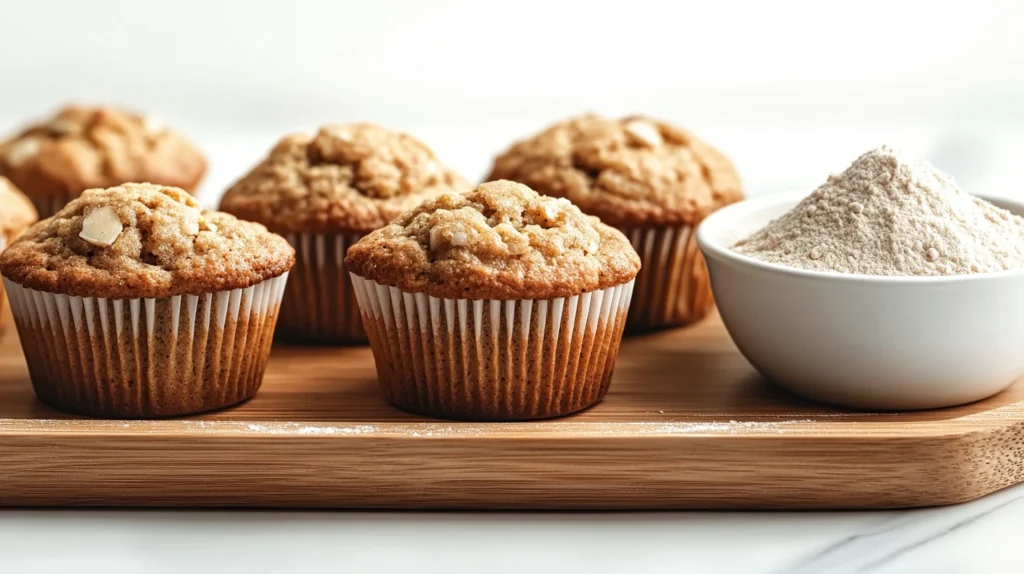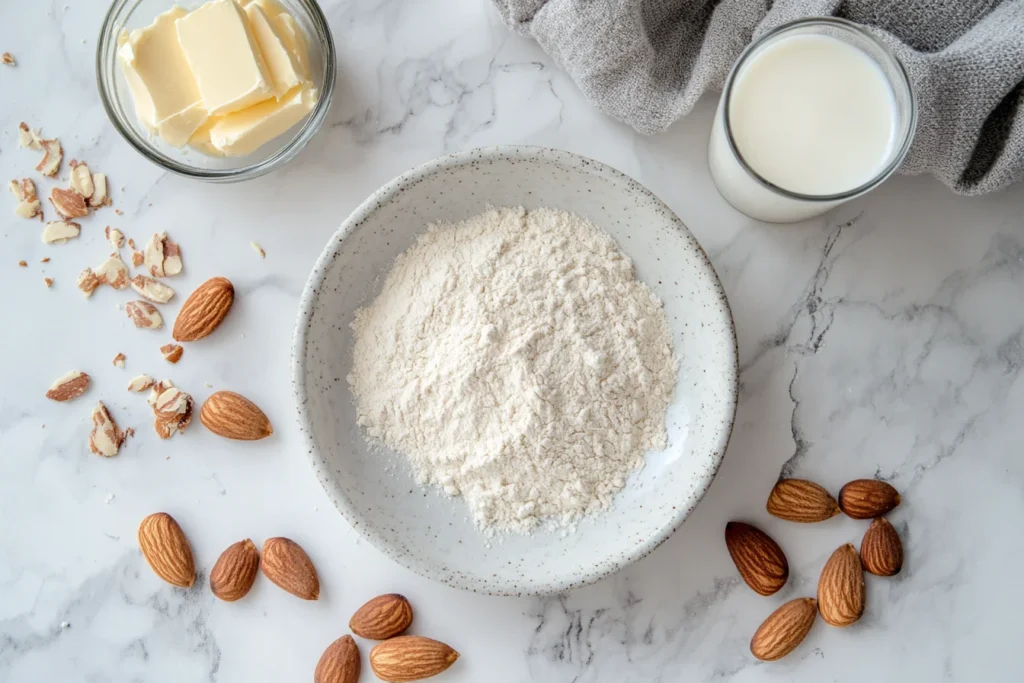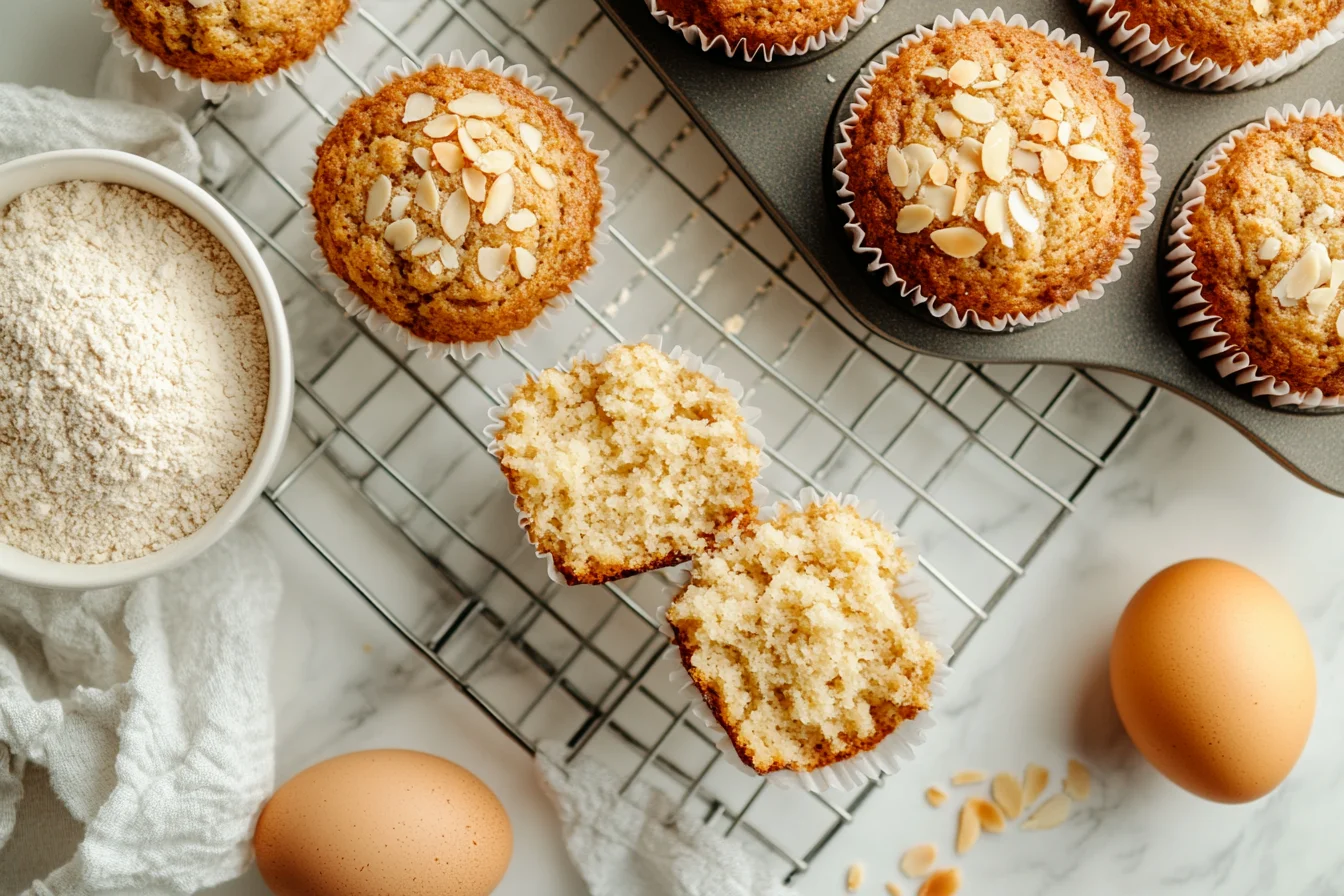Almond flour muffins are a popular choice among health-conscious bakers and those following gluten-free or low-carb diets. Yet, one common frustration stands out—crumbly muffins. If you’ve ever wondered, “Why are my almond flour muffins crumbly?” or struggled to keep them intact, you’re not alone. This article dives deep into the reasons behind crumbly almond flour muffins and provides easy fixes, step-by-step solutions, and expert tips to ensure your muffins turn out perfect every time.
Introduction
What This Article Covers
This article addresses the crumbling issues of almond flour muffins, from understanding the unique properties of almond flour to pinpointing common pitfalls in recipes. You’ll learn practical solutions, adjustments to ratios, and the use of alternative ingredients to achieve soft, moist muffins with a cohesive structure.
Why Focus on Almond Flour Muffins?
Almond flour is a star in gluten-free and low-carb baking because of its mild flavor and health benefits. However, it lacks the elasticity of traditional flour, making baked goods delicate and prone to crumbling. By the end of this guide, you’ll know exactly how to work with almond flour to produce muffins that are delicious and structurally sound.
Understanding Almond Flour
What Is Almond Flour?
Almond flour is a finely ground product made from blanched almonds with the skins removed. Unlike almond meal, which is coarser and includes the skins, almond flour has a smooth, powdery texture that makes it ideal for delicate baked goods like muffins. Its naturally gluten-free nature makes it a popular choice for people with dietary restrictions or those pursuing a healthier lifestyle.
What sets almond flour apart is its high-fat content, which gives baked goods a moist, tender crumb. However, this same property can make muffins prone to crumbling if the recipe isn’t perfectly balanced.
Nutritional Benefits of Almond Flour
Almond flour isn’t just versatile—it’s also packed with nutrients. It’s an excellent source of healthy fats, protein, and vitamin E. These nutrients make it not only great for baking but also a beneficial ingredient for your overall well-being. Additionally, almond flour has a low glycemic index, which means it won’t spike blood sugar levels like traditional flour.
Differences Between Almond Flour and Almond Meal
Understanding the difference between almond flour and almond meal is crucial for baking success. Almond flour is made from finely ground blanched almonds, while almond meal typically includes the almond skins and has a coarser texture. Using almond meal in place of almond flour can lead to denser, less cohesive muffins.
When recipes specifically call for almond flour, substituting almond meal can result in muffins that crumble more easily because the texture doesn’t bind as well. Always double-check the ingredient list to ensure you’re using the right type of almond-based product for your muffins.
Common Issues with Almond Flour Muffins
Why Are Almond Flour Muffins Prone to Crumbliness?
Almond flour is unique compared to traditional wheat flour. Without gluten—the protein that helps bind ingredients—muffins made with almond flour often lack structural integrity. This can result in crumbly baked goods that fall apart when handled. Furthermore, almond flour has a lower density and different absorption properties, meaning it doesn’t hold moisture or provide the same elasticity as all-purpose flour.
Another factor is the oil content in almond flour. While the natural fats contribute to a rich flavor and tender crumb, they can make the muffins more fragile, especially if the liquid-to-dry ratio in the recipe is off. Without sufficient binding agents, these challenges lead to muffins that crumble too easily.
How Almond Flour’s Texture Affects Baking
The fine texture of almond flour plays a dual role. On one hand, it ensures a smooth, delicate crumb. On the other hand, it can leave baked goods structurally weak. This is because almond flour particles don’t interlock the way gluten strands do, creating a lack of cohesion.
Additionally, almond flour doesn’t absorb liquid the way traditional flours do, which means recipes need to compensate by adding more binding ingredients or reducing excess moisture. Without these adjustments, the muffins may appear fine when baked but break apart after cooling.
Factors That Make Muffins Crumbly
Ingredient Ratios and Proportions
One of the main culprits behind crumbly almond flour muffins is an imbalance in ingredient ratios. Almond flour requires a delicate balance of dry and wet ingredients. Too much almond flour without enough liquid or fat can result in muffins that are dry and prone to breaking apart. On the flip side, using too much liquid can make the batter too loose, creating a fragile structure once baked.
Adding too much sweetener, particularly granulated ones, can also exacerbate the issue. Sweeteners contribute to the overall dry mix, and if the liquid ingredients don’t adequately offset this, crumbliness becomes unavoidable.
Overmixing: A Common Pitfall
It’s easy to assume that vigorous mixing would improve the consistency of your batter, but with almond flour, less is more. Overmixing can break down the particles of almond flour, releasing oils that affect the batter’s texture. This not only changes how the muffins bake but can also make the final product greasy and more likely to fall apart.
When preparing almond flour muffins, mix the batter just enough to combine the ingredients. Avoid overworking the batter, as it can destabilize the structure.
Lack of Binding Agents
Traditional wheat flour recipes rely on gluten for structure, but almond flour lacks this natural binding element. That’s where binding agents come into play. Without them, your muffins won’t hold together. Common binding agents for almond flour baking include:
- Eggs: The most effective option for creating structure and moisture.
- Xanthan Gum: Often used in gluten-free recipes, it acts as a stabilizer.
- Chia or Flaxseed Gels: Vegan-friendly alternatives that mimic the binding effects of eggs.
If your recipe doesn’t include any of these, it’s likely the reason your muffins are crumbling.
Baking Time and Temperature
Even the best batter can be ruined by improper baking. Almond flour muffins require a gentle balance of time and temperature. Baking at too high a heat can cause the muffins to rise too quickly, then collapse as they cool. Conversely, underbaking leaves them dense and prone to falling apart.
Aim for a moderate oven temperature—typically around 350°F (175°C)—and check for doneness by inserting a toothpick into the center. If it comes out clean, your muffins are ready. Overbaking can dry them out, leading to a crumbly texture.

How to Fix Crumbly Almond Flour Muffins
Adjusting Liquid Ratios
The right amount of liquid is crucial to keep almond flour muffins moist and cohesive. If your muffins crumble easily, try increasing the liquids in your recipe. Ingredients like almond milk, heavy cream, or even yogurt can help to bind the almond flour together while adding moisture.
A good rule of thumb is to start with small adjustments—add an extra tablespoon of liquid at a time. Be cautious not to overdo it, as too much liquid can make the batter too runny, which may result in flat, overly dense muffins.
Adding Binding Agents (e.g., Eggs, Xanthan Gum)
One of the easiest fixes for crumbly almond flour muffins is incorporating binding agents. Eggs are the most common choice, not just for binding but also for adding richness and structure. If your recipe already calls for eggs, consider adding an extra one for additional support.
For vegan alternatives, mix a tablespoon of ground flaxseed or chia seeds with three tablespoons of water to create a gel-like substitute. Xanthan gum or psyllium husk are also excellent options to improve batter cohesion, often requiring just a teaspoon to make a difference.
Best Practices for Mixing Almond Flour Batter
Mixing almond flour batter correctly is key to avoiding structural issues. Here are some tips to get it right:
- Don’t overmix: Combine ingredients until just incorporated.
- Add liquids gradually: To prevent batter from becoming too thin, add liquids a little at a time.
- Use a spatula: For better control, mix with a spatula rather than an electric mixer.
Overmixing breaks down almond flour particles, releasing oils and creating a greasy texture that contributes to crumbling. Aim for a smooth but firm consistency.
Oven Temperature Adjustments
Almond flour muffins bake best at moderate temperatures, typically between 325°F (163°C) and 350°F (175°C). If your muffins are crumbling, they may be overbaked or baked at too high a temperature.
- Check the temperature: Use an oven thermometer to ensure accuracy.
- Watch the bake time: Start checking muffins for doneness at the minimum bake time stated in your recipe.
Cooling the muffins properly is just as important as baking. Allow them to cool in the pan for about 10 minutes before transferring them to a wire rack. This prevents them from breaking apart while still hot.
Recipe Modifications for Better Results

Adding Moisture-Rich Ingredients
Incorporating ingredients that retain moisture can make a world of difference in preventing crumbly muffins. Some excellent choices include:
- Applesauce: A natural source of moisture and a mild sweetness that pairs well with almond flour.
- Mashed Bananas: Great for adding texture and flavor.
- Greek Yogurt or Sour Cream: These create a creamy batter and result in muffins that are tender and moist.
When adding these ingredients, adjust the liquid components in your recipe to maintain balance. For example, reduce oil or milk slightly when using moisture-rich additions like yogurt.
Incorporating Additional Flours (e.g., Coconut Flour)
Blending almond flour with other gluten-free flours can improve the structure and texture of your muffins. Coconut flour is a popular companion because it absorbs liquid efficiently and provides a denser crumb.
- Use a 3:1 ratio of almond flour to coconut flour.
- Increase the liquid in the recipe slightly to offset coconut flour’s absorbent nature.
This combination creates muffins that hold together better while retaining almond flour’s rich flavor and nutritional benefits.
Using Sweeteners That Enhance Texture
Not all sweeteners are created equal when it comes to baking. If you’re using granulated sweeteners like sugar or erythritol, consider switching to alternatives like:
- Honey or Maple Syrup: Natural liquid sweeteners that add moisture and help bind the batter.
- Brown Sugar: Adds a hint of molasses, which contributes to a softer texture.
Always remember to adjust other liquids in the recipe to keep the batter balanced when switching sweeteners.
Nutritional Content
Here’s a general overview of the nutritional content per 100g of almond flour muffins (ingredients may vary):
| Nutrient | Amount |
|---|---|
| Calories | 280 |
| Protein | 8g |
| Fat | 22g |
| Carbohydrates | 8g |
| Fiber | 3g |
| Sugar | 2g |
FAQs
Why Do My Muffins Fall Apart When I Remove Them?
If your almond flour muffins fall apart when you try to take them out of the pan, the issue is often due to improper cooling or a lack of binding agents. Allow muffins to cool in the pan for at least 10 minutes before attempting to remove them. Using parchment liners or greasing the pan thoroughly can also prevent sticking, which contributes to crumbling.
Can I Replace Almond Flour with Another Flour?
Yes, but substitutions require adjustments. Replacing almond flour with coconut flour, for example, requires additional liquid due to coconut flour’s high absorbency. All-purpose or whole wheat flour can be used in non-gluten-free recipes, but they’ll alter the texture and flavor significantly. Always use recipes specifically designed for your chosen flour to ensure success.
How Do I Prevent Muffins from Sticking to the Pan?
Sticking is a common cause of crumbly muffins. To prevent this, use parchment liners or a non-stick muffin pan sprayed lightly with oil. Silicone muffin molds are another excellent option for easy removal. Ensuring the muffins cool slightly before removing them also reduces the risk of breakage.
Are There Gluten-Free Binding Alternatives?
Yes, there are several binding alternatives that work well in almond flour baking. Options include:
- Eggs: The most reliable and effective option.
- Flaxseed or Chia Gels: Vegan-friendly and easy to prepare (1 tbsp ground flaxseed/chia + 3 tbsp water).
- Psyllium Husk: Adds elasticity and structure.
Experiment with these alternatives to find the best fit for your recipe.
Is Almond Flour Suitable for All Muffin Recipes?
While almond flour is versatile, it’s not always a one-to-one substitute for traditional flours. It works best in recipes specifically designed for its unique properties. If you want to adapt a standard muffin recipe, you’ll need to adjust the liquid ratios and add binding agents to ensure the muffins hold together.
Conclusion
Key Takeaways
Crumbly almond flour muffins may be frustrating, but the solutions are within reach. By understanding the properties of almond flour, carefully balancing ingredients, and using appropriate binding agents, you can transform your muffins into perfectly moist and structurally sound treats. Adjusting liquid ratios, mixing techniques, and baking times can further improve the texture and ensure your muffins stay intact.
Encouragement to Experiment
Baking with almond flour is as much an art as it is a science. Don’t be afraid to experiment with different ingredients like eggs, flaxseed gels, or coconut flour blends to find the perfect balance for your muffins. Each attempt brings you closer to mastering the delicate craft of gluten-free baking.
With a little patience and the tips shared in this guide, your almond flour muffins will not only look amazing but also hold together beautifully and taste fantastic. Happy baking!


3 thoughts on “Why Are My Almond Flour Muffins Crumbly? Causes and Fixes”